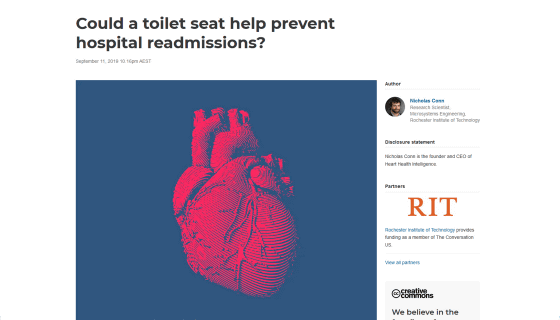What are the benefits of 'attaching a sensor to the toilet seat to monitor for signs of heart disease'?

In today's aging society, which is accelerating with the development of medical care and a decrease in the birth rate, more and more people are living with heart problems. Attention is being paid to a method of monitoring the heart, which is important for people with a chronic heart condition, by using a sensor attached to the toilet seat.
Could a toilet seat help prevent hospital readmissions?

In the United States, where the population over the age of 65 is expected to double in the next 40 years, nearly 80% of the elderly are said to have some form of heart disease. With the advancement of medicine, as a result of being able to survive even with some heart disease, the number of people living with
As many as 6.5 million people in the United States treat congestive heart failure, spending $ 35 billion a year on treatment. It seems that about 80% of treatment costs are due to hospitalization in patients with congestive heart failure, but 50% of patients who are hospitalized after being diagnosed with congestive heart failure return to hospital within 90 days after being discharged It seems close.
One possible reason for the high readmission rate of patients with congestive heart failure is that the intermittent treatment at the medical institution after discharge leads to missing signs of worsening congestive heart failure. Patients who do not take prescribed medications properly or fail to monitor blood pressure and other conditions on their own can also cause heart failure to recur. Doctors recommend regular monitoring of blood pressure, etc., for patients, but less than 10% of patients with congestive heart failure do so regularly.

To monitor the risk of congestive heart failure, doctors and patients use sphygmomanometers, scales, and hand-held electrocardiogram monitors, and after discharge, patients must monitor their own health. However,
CardioMEMS is the only new technology approved by the U.S. Food and Drug Administration (FDA) to more easily monitor the status of patients with congestive heart failure, which measures blood pressure by implanting an implant in the pulmonary artery. In clinical trials, CardioMEMS has been shown to reduce the number of patients hospitalized for congestive heart failure by 37%, and the average medical cost per year after implant implantation is reduced by $ 13,190 (about 1.25 million yen) There are also research results (PDF file) .
While there are high expectations for monitoring devices such as CardioMEMS, there are also concerns about the burden of implants and other devices on heart patients. Also, even with wearable devices that can be worn, the wearer must eventually have the will to actively monitor his own situation, and he may stop monitoring on the way.

So, researchers
When monitoring for congestive heart failure in the toilet seat, unlike existing monitoring devices used in hospitals and patients' homes, it is necessary to measure the amount of oxygen in the blood from the 'artery behind the thigh' instead of the finger Measurement methods that deviate from the standard are required. In the four years since the idea was conceived in 2014, the research team has developed new sensors and custom circuits and algorithms to correct noisy measurement data.
While sitting on the toilet seat, the patient doesn't need to do anything, Conn claims, just sit down to get the job done and monitoring is complete. The monitoring method using the toilet seat is already undergoing clinical trials with more than 300 people, and FDA approval will be obtained in 2021. Once approved, Conn said he wanted to put a monitoring sensor on the toilet seat.

Related Posts:







